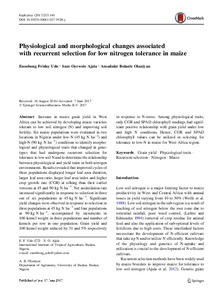| dc.contributor.author | Udo, E.F. |
| dc.contributor.author | Ajala, S.O. |
| dc.contributor.author | Olaniyan, A.B. |
| dc.date.accessioned | 2019-12-04T11:08:48Z |
| dc.date.available | 2019-12-04T11:08:48Z |
| dc.date.issued | 2017-06-17 |
| dc.identifier.citation | Udo, E.F., Ajala, S.O. & Olaniyan, A.B. (2017). Physiological and morphological changes associated with recurrent selection for low nitrogen tolerance in maize. Euphytica, 213(7), 1-13. |
| dc.identifier.issn | 0014-2336 |
| dc.identifier.uri | https://hdl.handle.net/20.500.12478/1914 |
| dc.description | Published online: 17 June 2017 |
| dc.description.abstract | Increase in maize grain yield in West Africa can be achieved by developing maize varieties tolerant to low soil nitrogen (N) and improving soil fertility. Six maize populations were evaluated in two locations in Nigeria under low-N (45 kg N ha−1) and high-N (90 kg N ha−1) conditions to identify morphological and physiological traits that changed in genotypes that had undergone recurrent selection for tolerance to low soil N and to determine the relationship between physiological and yield traits in both nitrogen environments. Results revealed that improved cycles of three populations displayed longer leaf area duration, larger leaf area ratio, larger leaf area index and higher crop growth rate (CGR) at silking than their earlier versions at 45 and 90 kg N ha−1. Net assimilation rate increased significantly in response to selection in three out of six populations at 45 kg N ha−1. Significant yield changes were observed in response to selection in three populations at 45 kg N ha−1 and four populations at 90 kg N ha−1, accompanied by increments in 100 kernel weight in three populations and number of kernels per row in one population. Grain yield and 100 kernel weight reduced by 31 and 5% respectively in response to N-stress. Among physiological traits, only CGR and SPAD chlorophyll readings had significant positive relationship with grain yield under low and high N conditions. Hence, CGR and SPAD chlorophyll values can be utilized in selecting for tolerance to low-N in maize for West Africa region. |
| dc.description.sponsorship | African Development Bank |
| dc.format.extent | 1-13 |
| dc.language.iso | en |
| dc.subject | Recurrent Selection |
| dc.subject | Maize |
| dc.subject | Yield |
| dc.subject | Physiological Traits |
| dc.subject | Morphological Traits |
| dc.subject | Soil Nitrogen |
| dc.title | Physiological and morphological changes associated with recurrent selection for low nitrogen tolerance in maize |
| dc.type | Journal Article |
| dc.description.version | Peer Review |
| cg.contributor.crp | Maize |
| cg.contributor.affiliation | International Institute of Tropical Agriculture |
| cg.contributor.affiliation | University of Ibadan |
| cg.coverage.region | Africa |
| cg.coverage.region | West Africa |
| cg.coverage.country | Nigeria |
| cg.isijournal | ISI Journal |
| cg.authorship.types | CGIAR and developing country institute |
| cg.iitasubject | Maize |
| cg.journal | Euphytica |
| cg.howpublished | Formally Published |
| cg.accessibilitystatus | Limited Access |
| local.dspaceid | 85032 |
| cg.targetaudience | Scientists |
| cg.identifier.doi | https://dx.doi.org/10.1007/s10681-017-1928-y |

